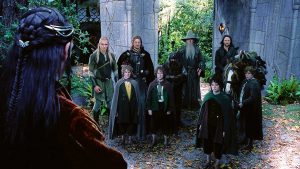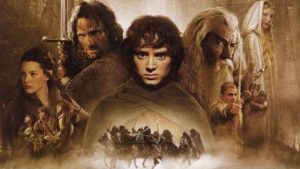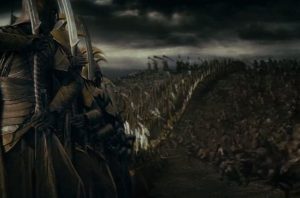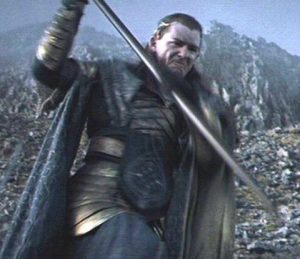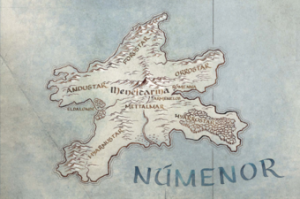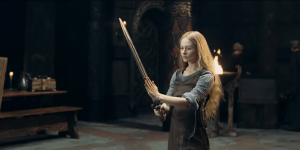The recent reveal of an official synopsis for Amazon Prime’s The Lord Of The Rings adaptation has left us all excited to jump back into Middle-earth and revel in the many joys it has to offer us. But to get fully prepared for Amazon’s upcoming series requires more than just a movie marathon or even a reread of J.R.R. Tolkien’s The Lord Of The Rings – Amazon is pulling from Tolkien’s extensive deep lore for their series, and diving into regions of Middle-earth previously unexplored by either the films or main books.

Eregion, however, has a rare distinction in that, although it’s glimpsed in both the books (the Fellowship of the Ring passes through its ruins on their journey south from Rivendell), and the movies (in fact, it’s the very first location you see in Jackson’s trilogy, while Cate Blanchett is narrating the history of the One Ring), its most prominent exposure to date is in the deeply flawed Middle-earth video games, Shadow Of Mordor and Shadow Of War. These games break Tolkien lore in ways that are frankly appalling (Shelob is a shape-shifting sorceress, Isildur is a Nazgûl, and Celebrimbor’s ghost becomes one half of Sauron’s fiery eye). But they did at least give players a basic rundown of the history of Celebrimbor, Eregion, and the forging of the Rings of Power in the Second Age – events that will be pivotal to Amazon’s series, set in the same time-frame. That being said, the non-canonical and hyperbolic nature of the games makes them a faulty source for accurate information…which is my long-winded way of saying “trust me instead”.
I recounted some of the ancient history of the Elves in Middle-earth while discussing Lindon and the Grey Havens, so what immediately follows may be familiar to some of my readers. But while the paths of Lindon and Eregion diverged early in the Second Age, they have a common root in the First Age, during a mythical, peaceful era before the creation of the sun and moon and thus beyond the margins of recorded history. During this time-before-time, Middle-earth was only one half of a flat, disc-shaped world – its other half being the paradisiacal continent known as Valinor, where a pantheon of benevolent gods named Valar presided over a flourishing community of Elves well-versed in all the arts and sciences available to them: and even some beyond our modern capabilities. In the absence of a sun, Valinor’s primary light source was a duo of glowing trees, which is a random important detail.
The most creative-minded Elves in Valinor were the Noldor Elves, and the greatest among them was Fëanor, an inventor who had foresight as well as unparalleled skill and an indomitable ego. He’s a bit of a divisive figure in-universe: everyone had mad respect for his accomplishments, and he did create a trinity of magical gems called Silmarils to house the light of the Two Trees of Valinor, because he accurately predicted that the evil Morgoth would kill the Trees and plunge Valinor into darkness…he just didn’t foresee the bit where Morgoth also stole the Silmarils. Fëanor’s backup plan for his backup plan involved leading most of the Noldor on a wild-goose chase to Middle-earth to try and find Morgoth, killing any Elves who stood in their way: all of this, mind you, against the orders of the Valar, who forbade any of them to return to Valinor after what they had done. And then Fëanor got himself killed roughly ten minutes into the expedition (yes, minutes: while the Noldor were freaking out, the Valar had gone and fixed the whole light-source problem by creating the sun, adding insult to injury), leaving his followers leaderless and stranded in Middle-earth with Morgoth, and saddling his descendants with an unbreakable oath to recover the Silmarils or die trying.
Only Tolkien could take this comedic gold and write it as an epic tragedy.

Needless to say, the Noldor were really angry and really confused about their life-choices by the time the First Age ended and the Valar finally arrived to set things straight, casting Morgoth into the void. The Valar offered them all a choice to return to Valinor and repent for their crimes, but most of the Noldor refused out of pride, bitterness, or a desire to prove they could be self-sufficient. For some, it was all three – plus an almost subliminal urge to build Middle-earth into a mirror image of Valinor and rival the glory of the gods. Never a good idea, especially when the gods are real and prone to violence. But the main proponent of this philosophy was Fëanor’s grandson, Celebrimbor, so…yeah, not surprising at all.
Celebrimbor lived in Lindon under King Gil-galad during the early years of the Second Age, but eventually grew bored and struck off on his own. Charismatic like his grandfather, he attracted a large following – and was soon able to build his own kingdom in the foothills of the Misty Mountains, which he called Eregion. Celebrimbor was actually a decent leader. He was on good terms with the neighboring Dwarves of Khazad-dûm, with whom he traded knowledge and precious mithril steel (also, him and Narvi the Dwarf were totally doing the whole “forbidden love” thing centuries before Tauriel and Kili, or Legolas and Gimli). He promoted the arts, set up a guild of crafts-people, and began work on his agenda to make heaven a place on Middle-earth. Eregion even attracted guests like Galadriel and Celeborn, who lived there for a time.
But Celebrimbor’s frantic urge to outdo the Valar made him the perfect target for Sauron, a fallen angel who had served Morgoth, and who now rose to fill the power-vacuum left in his wake. A tyrannical perfectionist, Sauron’s ultimate goal was similar to Celebrimbor’s – he too wanted to elevate Middle-earth above and beyond its mortal limitations, but he was uniquely hindered by his inability to create real beauty. Nonetheless, wearing the beautiful disguise of an Elven emissary from Valinor named Annatar, he was able to infiltrate Eregion and seduce the Noldor with his repeated assurances that the Valar wished for them to redesign Middle-earth in the image of paradise. Thus, Sauron was able to harness the skill of the Elves for his own purposes.
Together, each learning from the other, Celebrimbor and Annatar forged sixteen Rings of Power. These were not distributed immediately to Men and Dwarves, as the movies indicate (Tolkien toyed with the notion that Celebrimbor only gave away one in his lifetime: to Durin III, King of Khazad-dûm, as a token of friendship). Celebrimbor had designed these Rings to be worn by Elves, to help and heal Middle-earth; and it was Sauron’s secret hope that he could control the Elves through their Rings, into which he had poured dark magic of his own. In Second Age 1600, having sufficiently mastered the art of Ring-making and confident that the Noldor would wear the Rings he had helped make for them, Sauron left Eregion and returned to his own land, in foul Mordor. But he underestimated the perfectionism he had instilled in his followers: the Noldor he had left behind continued work on three more Rings of their own, far greater than the sixteen.
In Mordor, Sauron secretly forged One Ring – a Master Ring with the power to ensnare all others and their wearers. But as soon as he put it on, Celebrimbor became aware of his treachery, and demanded that the newly-finished Three Rings be distributed swiftly to the greatest leaders of the Elven people, Gil-galad, Galadriel, and Círdan, and hidden from Sauron forever. They were not made by Sauron, so he could not control them from afar, but they were made with knowledge learned from him; and were thus tied to his fate, and that of the One Ring.

Sauron nonetheless perceived that Eregion was his greatest threat, and threw all his force against the Elven kingdom. With the help of orc-armies, he ransacked and destroyed the forges of the Noldor, and captured Celebrimbor. The king was ruthlessly tortured until he revealed the locations of the sixteen Rings (or fifteen, assuming Durin III already had one), which Sauron quickly recovered. But he would say nothing of the Three Rings, and Sauron eventually had him killed, thus ending the line of Fëanor. His brutally-mangled body was hung on a pole and used by Sauron’s armies as a banner in their war against the Elves.
With Eregion destroyed, no new Rings would ever be forged, nor would Celebrimbor’s purpose for them be achieved. Middle-earth sank further into darkness and despair as Sauron begrudgingly distributed his stolen Rings among Dwarves and Men, since his plan to control the Elves had backfired. Men were easily corruptible, but the Dwarves proved resistant, and their rings became the foundations of great treasure-hoards under the earth. The Three Rings were not used during the Second Age.
The survivors from Eregion dispersed across Middle-earth, mainly to Lindon and the refuge of Rivendell, but many became disheartened, sailing back to the Undying Lands in Valinor. By the end of the Third Age, Eregion was a tumbled heap of ruins, and even the stones on which its foundations had been built had long since forgotten the Elves, their Rings of Power, and all their dreams of paradise. Now that’s tragic.
